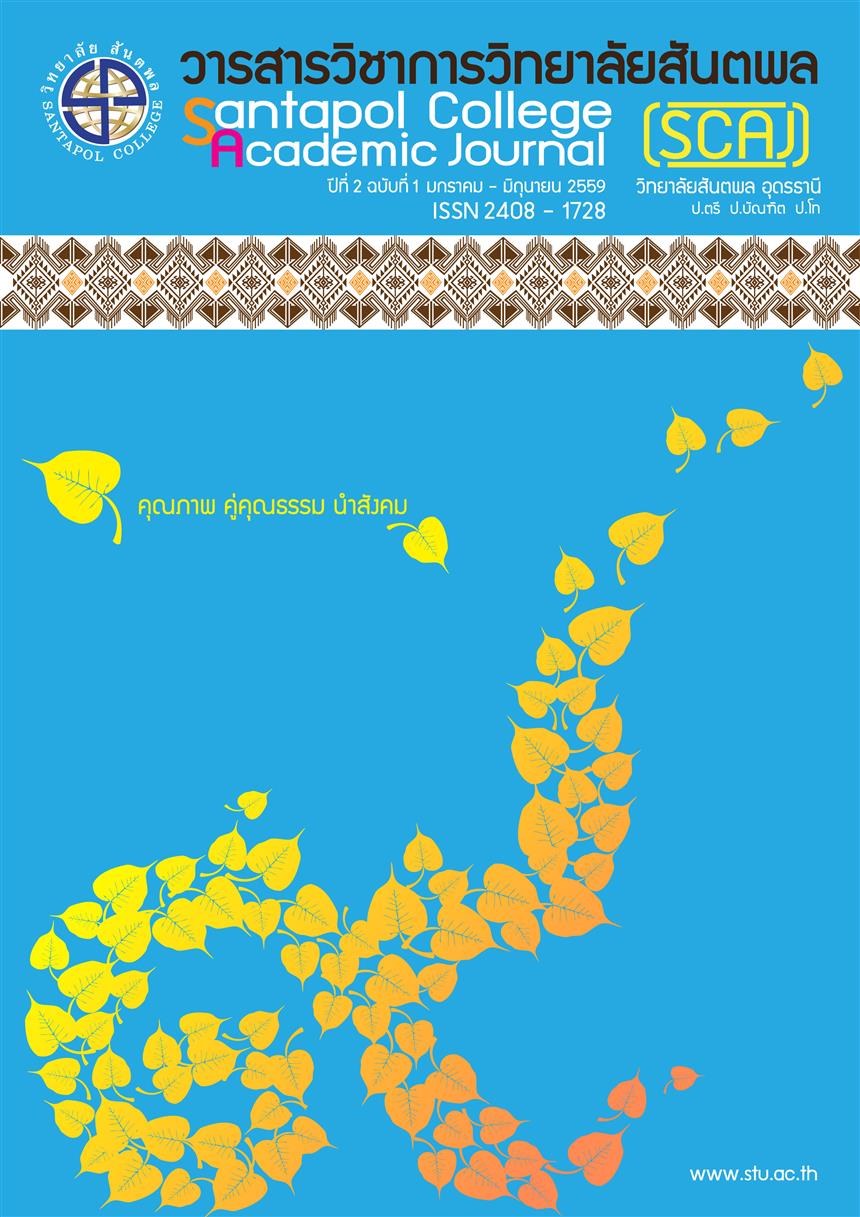THE ANALYZING OF BRAND EQUITY CONCEPTION IN THAILAND: AN EMPIRICAL STUDY FROM A DOCUMENTARY RESEARCH
Main Article Content
บทคัดย่อ
The study investigates to analysis of brand equity conception in Thailand by using a documentary research. The 113 full reports of master thesis and doctoral, which announced between 1998 - 2013 from the electronic data base Thai Digital Collection (ThaiLis) and Digital Research Information Centre (NRCT), were inspecting of this study. The research characteristics recording form was construct as the research instrument. The data utilized analysis by frequency and percentage for composing and abridging the significant.
The finding of the study extended that mostly researches were explored in 2010 – 2013 (49.6%), mostly examined from independent study of master degree (IS) (53.1%). For 73.5% of business administration studies were mostly department program, using the quantitative method (94.7%) with questionnaire as the research instrument (97.3%). Multi-Stage Random Sampling of 56.7% was essentially adopted and considered from the personal goods and health care (28.30%). Predominantly statistics were determined by correlation coefficient, One-way ANOVA, t-test, regression analysis, Chi-square, exploratory factor analysis, confirmatory factor analysis, structural equation modelling, mean, standard deviation and MANOVA.
Most of them concentrated merely on the brand equity conception of Aaker (1991, 1996) and Keller (1993). The top five dimensions were comprised brand awareness (98.20%), brand association (84.10%), brand perceived quality (73.50%), brand loyalty (70.80%) and brand image (30.10%). The research discovery entailed that the brand equity philosophy of Thailand defined to approach and theory anticipates the western context. The researches and academics should be inspired to manipulate advance exploration in the issues of white investigations. The forthcoming research demand to discover that what the brand equity dimensions are appropriate for the Thai social – culture and Thai consumer by qualitative research method which static not developed theses notion in Thailand.
Article Details

This work is licensed under a Creative Commons Attribution-NonCommercial-NoDerivatives 4.0 International License.
เนื้อหาและข้อมูลในบทความที่ลงตีพิมพ์ในวารสารวิชาการวิทยาลัยสันตพล ถือว่าเป็นข้อคิดเห็นและความรับผิดชอบของผู้เขียนบทความโดยตรง ซึ่งกองบรรณาธิการวารสารไม่จำเป็นต้องเห็นด้วยหรือรับผิดชอบใดๆ
References
Aaker, D.A. (1996). Building Strong Brand. New York: the free Press.
Anantachart, S. (1998). A Theoretical Study of Brand Equity: Reconceptualizing and Measuring the Construct From an Individual Consumer Perspective. Dissertation. University of Florida.
Anderson, J. (2007). Brand Equity: The Perpetuity Perspective. Proceedings of the American Marketing Association.
Auken, B. V. (2002). The Brand Checklist. London: Kogan Page.
Bailey, R. and Ball, S. (2006). An exploration of the meanings of hotel brand equity. The Service Industries Journal, Vol. 26 No. 1, pp. 15-38.
Baalbaki, S., S. (2012). Consumer Perception of Brand Equity Measurement; a New scale. Dissertation. University North Texas.
Berry, L. (2000). Cultivating Service Brand Equity. Journal of the Academy of Marketing Science, 28(1), 128-37.
Bulratana, D. (1998). The Measurement of Brand Equity in Beer Category. Thesis. Chulalongkorn University.
Chaokasem, K. (2007). Brand Equity Measurement in Whitening Cosmetic Product in Chiang Mai Province. Independent Study. Chiang Mai University.
Cobb-Walgren, C, J., Ruble., and Donthu., N. (1995). Brand Equity, Brand Preference, and Purchase Intent. Journal of Advertising, 24(3), 25-40.
Creswell, J, W. (2003). Research Design: Qualitative, Quantitative and Mixed Methods Approaches. Thousand Oaks, Sage.
Doyle, P. (2001). Shareholder-Value-Based Brand Strategies. Journal of Brand Management, 9 (1), 20-30.
Farquhar, Peter H. (1989). Managing Brand Equity. Marketing Research, 1 (September), 24-33.
Grant, J. (2006). The Brand Innovation Manifesto. England: John Wiley and Sons Ltd.
Hesse - Boeber, S. N. (2010). Mixed Methods Research: Merging Theory with Practice. New York, the Guilford Press.
Lovelock, C. and Wirtz, J. (2005). Services Marketing in Asia: A Casebook. Singapore: Pearson Education.
Keller, K. L. (1993). Conceptualizing, Measuring, and Managing Customer- Based Brand Equity. Journal of Marketing, 57(1), 1-22.
Keller, K. L. and Lehmann, D. R. (2006). Brands and Branding: Research Findings and Future Priority. Marketing Science, 25 (6), 740-59.
King, C. and Grace, D. (2009). Employee Based Brand Equity: A Third Perspective. Services Marketing Quarterly, 30, 122-147.
Kotler, P.(2003). Marketing Management. The Millennium Edition, Upper Saddle River, Prentice Hall.
Kreitner, R. (1998). Management. Boston, MA, Houghton Mifflin.
Lee., G. C., Leh., F. C. Yew. (2011). Dimensions of Customer- Based Brand Equity: A Study on Malaysian Brands. Journal of Marketing Research and Case Studies.
Malhotra, N.K. (2010). Marketing Research: An Applied Orientation. (Sixth Edition). Pearson Education. Inc., Upper Saddle River.
Park, C.S. and Srinivasan, V. (1994). A survey-based method for measuring and understanding brand equity and its extendibility. Journal of Marketing Research, Vol. 31, May, pp. 271-88.
Pappu, R.; Quester, P.G. and Cooksey, R.W. (2005). Consumer-based brand equity: Improving the measurement – empirical evidence. Journal of Product and Brand Management. 14(3). 143 - 154.
Punyaprabhasara, C. (2012). Refining Consumer-Based Brand Equity Measurement Scale: Measurement Effects on Brand Preference and Purchase Intention. Dissertation. Burapha University.
Pongcharoenkul, C. (2010). Measuring Consumer-based Brand Equity of NACHA Coffee in Chiang Mai Province. Independent Study. Chiang Mai University.
Rajasekar, N. and K.G. N. (2008). Measuring Customer-Based Brand Equity in Durable Goods Industry. Journal ofMarketing and Communication, 4(1),
48-58.
Rodsuwan, W. (2011). Brand Equity Comparison Between Starbucks and Wawee Coffee in Mueang Chiang Mai District. Independent Study. Chiang Mai University.
Swanson, R. A. and Holton III, E. F. (2001). Foundation of Human Recourse Development. San Francisco, Berrett-Koehler.
Simon, C. J. and Sullivan, M. W. (1993), The Measurements and Determinants of Brand Equity: A Financial Approach. Marketing Science, 12(1), 28-52.
Taweeapiradeeviroj, T. (2011). Measuring Consumer-based Brand Equity of NACHA Coffee in Phuket Province. Independent Study. Chiang Mai University.

